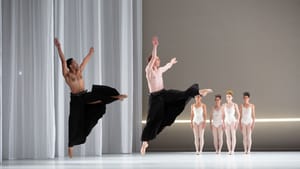Stay in the Loop
BSR publishes on a weekly schedule, with an email newsletter every Wednesday and Thursday morning. There’s no paywall, and subscribing is always free.
A full-circle performance
The Philadelphia Ballet presents Hans van Manen’s Humankind

There’s poetic symmetry to Humankind at the Philadelphia Ballet this week. In 1974, the company was the first in the United States to stage Dutch choreographer Hans van Manen’s work. It was a natural collaboration: artistic director Benjamin Harkarvy had previously co-directed the Netherland National Ballet with van Manen, so they knew each other well. Now, as the 90-year-old van Manen announces that he will no longer be choreographing, it seems a fitting time to revisit that relationship with three pieces spanning his long career.
Too sexy for my skirt
Grosse Fuge was not my favorite piece of the night, but it is certainly the most intriguing. On a stage bathed in soft white light picked up by diaphanous panels at the wings, four men enter in long black skirts slit on the side to reveal a bit of leg, showing off their muscles. Sterling Baca flexes his arms, and Zecheng Liang strikes martial poses, his hands clenched in fists or arched in a gesture that characterizes much of van Manen’s work.
The women, in pristine white leotards, look on in cool indifference best summed up when Mayara Pineiro kicks Jack Thomas to the curb with little flicks of her foot as he scuttles backward in a plank position until he disappears into the wings. In group pieces, the dancers pace in intricate crossing steps and hop up and down, the women in the air as the men land and vice versa, picking up the sometimes-frenetic pace of Beethoven’s Grosse Fuge, op. 133.
The flirting gets downright erotic once the men take off their skirts, revealing big belts and tiny shorts, and the music slows down with the Cavatina, op. 130. The women bridge the men, who slide out from under and then straddle their partners, who grab the aforementioned belts. The men straighten their legs, lifting the women a bit off the ground before sliding them across the stage in sweeping passes. Van Manen designed the costumes, and the lighting, created by Joop Caboort and relit by Bert Dalhuijsen, managed to be both stark and dream-like at the same time. It’s a dazzling piece that brings the in-your-face sexuality of the early 1970s to a different century.
Two Couples, 5 Tangos
My favorite piece of the night is the shortest, and for the audience, the simplest. Van Manen created Variations for Two Couples in 2012 and set it to snippets of various composers from Benjamin Britten to a hint of tango from Astor Piazzolla. Jermel Johnson has talked about his softer interpretation of the princely roles, and he brings that gallant romanticism to his duet with Oksana Maslova, she in costume designer Keso Dekker’s jewel-like purple bodysuit and he in a grey that gave her the spotlight. They are gorgeous together, combining their flawless technique with a connection that seems to embrace Maslova even at arms’ length. In its best moments, it draws us into the connection, folding us into their embrace as well. The contrast to Arian Molina Soca’s bravura display for Dayesi Torriente gave the dance an extra layer of texture.
The evening ended with the thoroughly enjoyable 5 Tangos. Van Manen said that after a friend introduced him to Piazzolla’s music, he had to choreograph to it, and that love of the music came through in the dancing. It was the largest piece of the night, with 14 dancers, the men in black and the women in knee-length red and black dresses, and when they filled the stage together you could imagine yourself in a smokey bar in Argentina, pointe shoes and all.

Nayara Lopes held us, and the male dancers, in the palm of her hand, half kneeling while the men danced behind her, then rising to dance with first one, then another, passing among them. They lift her overhead, then she knocks them dead with a flourish of her arms, queen of the dance. Ashton Roxander dances with surprising maturity in a solo that has all the power of a true tango with a series of turns and kicks that end with an impassioned slide on his knees. The duet between Peter Weil and Russell Ducker presents two bravos warily sizing each other up while circling each other at a distance, then drawing closer with the challenge.
Johnson’s farewell
Humankind marks a return to van Manen’s choreography but a farewell to dancer Jermel Johnson, who is retiring after this series. Johnson is notable as the first Black principal dancer in the company, of course. But we will remember him for the elegance and sensitivity of his dancing, his glorious gravity-defying leaps, and the heart he brought to everything he did. He has been one of my favorite dancers throughout his career. Like many in the dance community, I will miss him.
What, When, Where
Humankind. Choreography by Hans van Manen. Philadelphia Ballet, presented by the Kimmel Cultural Campus. $25. Through May 15, 2022, at the Academy of Music, 240 S. Broad Street, Philadelphia. (215) 893-1999 or philadelphiaballet.org.
The Kimmel Cultural Campus requires all patrons aged five years or older to be fully vaccinated against Covid-19. Masks are required at all times inside the concert hall. Seating is not distanced.
Accessibility
The Kimmel Cultural Campus is an ADA-compliant venue. Patrons can purchase wheelchair seating or loose chairs online by calling Patron Services at (215) 893-1999, or by emailing [email protected]. With advance notice, Patron Services can provide options for personal care attendants, American Sign Language, Braille tickets and programs, audio descriptions, and other services.
Sign up for our newsletter
All of the week's new articles, all in one place. Sign up for the free weekly BSR newsletters, and don't miss a conversation.
 Camille Bacon-Smith
Camille Bacon-Smith